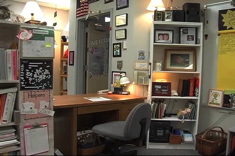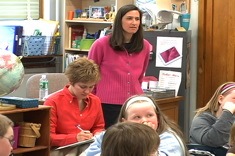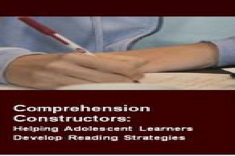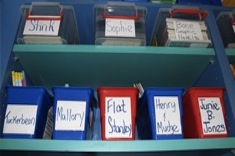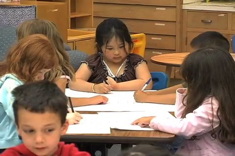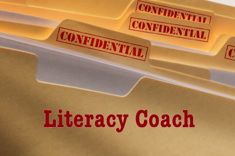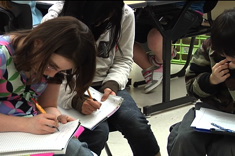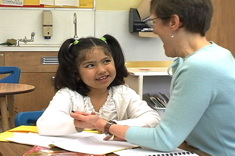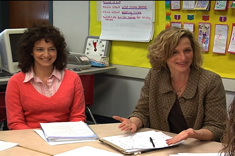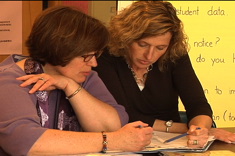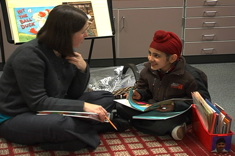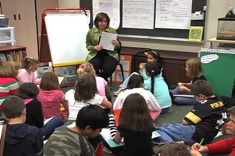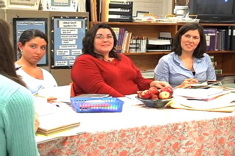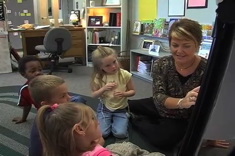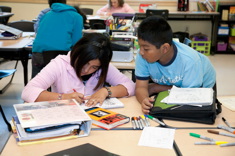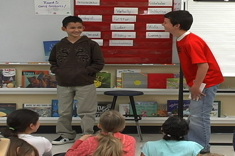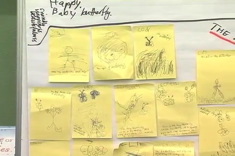Library
Choice Literacy Articles & Videos
The Choice Literacy library contains over 3,000 articles and 900 videos from 150+ contributors. Classic Classroom and Literacy Leadership subscribers have access to the entire library. Content is updated continuously, with five to six new features published each week.
Latest Content
Understanding the “Silent Period” with English Language Learners
Ruth Shagoury and Andie Cunningham explain how to support an English Language Learner who is not speaking with verbal and nonverbal communication strategies.
Let’s Get Rid of “The Teacher Shrine”: Organizing Meeting Areas, Walls, and Materials
In this brief classroom tour, Gail Boushey and Joan Moser (“The Sisters”) talk about problems with teacher desks, present how they separate and define different curricular learning areas.
Tips from the Pros on Starting Your Own Writer’s Notebook or Teaching Journal
If you asked yourself, “What in this world do I never want to forget?” what might go in your notebook? Brenda Power offers routines and rhythms to write like the pros.
Reflective Observation: Helping Teachers Observe, Analyze, and Guide (TEMPLATE)
This template helps teachers focus their classroom observations.
Designing Comprehension Constructors: Helping Adolescent Learners Develop Reading Strategies (E-GUIDE)
Comprehension constructors are a terrific tool for helping teens record their understanding.
Whole-Class Vocabulary Lesson, Grades K-2
In this five-minute video, Joan Moser of “The Sisters” teaches a whole-class vocabulary lesson. The focus is on helping students notice interesting words, and make connections between daily read-alouds and word learning.
Chapter Book Read Alouds in the Primary Classroom
Shari Frost considers selection, preparation, and pacing in choosing books that work well as read alouds in the primary classroom.
Webbing to Learn: A Writing Strategy to Chart Thinking with Young Learners
Andie Cunningham and Ruth Shagoury explain how webs can be a powerful organizing tool for kindergarten writers.
Literacy Coach Confidential: Some Study Group Participants Aren’t Reading the Book
Have you ever experienced the strange phenomenon of colleagues who show up for book study groups and gab away, even though they haven't read the text? You may be a victim of "bullcrit" – the willingness of some people to critique movies they haven't seen, music they haven't heard, and books they haven't read.
Up Gross and Personal: Dealing with Dicey Topics in Writing Workshops
Even teachers with a high tolerance for the disgusting can get a little squeamish at the topics students choose for writing workshops. What are the boundaries of good taste?
My Son Clark Kent
Lisa Koch shares a parent's perspective of the damage too much emphasis on reading levels in the classroom does to her young son.
Introducing Bull’s-Eye and Waves Written Responses in Synthesis Work
Andie Cunningham explains the bull’s-eye and wave responses her kindergartners complete to demonstrate their understanding of synthesis. A video introducing the activity is included.
Assessment and Curriculum Mapping
In this video from a new teacher study group for grades 3-5 teachers, Jennifer Allen demonstrates how teachers can use assessment data to develop instructional plans for individual students and create curriculum maps for an entire class of students.
The Art of Listening in Writing Conferences with English Language Learners
Ruth Shagoury and Andie Cunningham share tips for mastering the art of listening in conferences with English language learners.
Revision Tools: Providing Options to Students
From old favorites like highlighters to new resources like kangaroo bags, this whole-class session with Franki Sibberson's grades 3-4 students highlights cool tools that will inspire learners to dive in and test out different revision strategies in writer's workshop.
Four Essentials in Designing Professional Development for Literacy Leaders
While clever activities for adult professional development are fun, what really helps colleagues become more competent and sensitive to classroom and school needs? Franki Sibberson knows what her colleagues need and gives it to them.
Starting Points: Easy Beginnings for Writing Better Narrative Assessments and Report Card Comments
If you struggle as a writer at report card time, these tips might give you ideas for streamlining your work.
Helping Young Readers Understand the Middle East: A Booklist of the Best Fiction Picture Books
Do your books reflect the images of your learners' families and culture? Ruth Shagoury offers a booklist to explore the Arab and Persian world.
Reflection Sheets: A Tool for Assessment and Conferring
Franki Sibberson explains how “reflection sheets” work as an assessment tool in her classroom, replacing detailed notes from conferences.
Teacher Study Group: Writing Focus
In this video of a teacher study group, Jennifer Allen leads a group of grades 3-5 teachers as they launch their monthly meeting in October.
The Dark Side of Girl Talk: How Female Conversation Patterns Can Inhibit School Change
Brenda Power explores the differences between “rapport talk” and “report talk” and what to do when communication breaks down with female colleagues.
Flexible Groups: Moving Beyond Levels to Assess Reading Needs
Gail Boushey and Joan Moser (“The Sisters”) discuss how their thinking has evolved when it comes to flexible groups. The article includes a video excerpt of Joan working with a group of kindergartners.
Minilessons to Start Conversations with Students About Books
In leadership positions, the first conversations with students about who you are and what you believe can set the tone for the year. Franki Sibberson has helpful advice for talking with readers — big and small.
Family Survey: Report Cards and Evaluations (SURVEY)
Here’s a quick and easy family survey to send home with students.
The “All About Us” Board: Linking Literacy and Community Building All Year Long
Suzy Kaback has terrific tips for an ever-evolving “All About Us” bulletin board to use from the first day of school to the last.
Concepts of Print: Conferring with a Kindergartner
In this conference with five-year-old Mariano, Joan Moser (of “The Sisters”) assesses his understanding of reading, print, and books at the start of the school year.
Creating Anchor Charts with Sticky Note Responses from Young Readers
Over-sized sticky notes are a great learning tool for kindergartners. In this video, Andie Cunningham demonstrates how she uses them with her students.
Guilty Pleasures
Aimee Buckner reveals her guilty pleasures, and finds they make for great writing fodder.
The Lines are to Write My Words: Phonics in Context
Ruth Shagoury considers the role of phonics in context as she observes a classroom built on a foundation of children's expert knowledge as writers.
On Kidney Tables: Small Changes for Big Effects
When our environment aligns with our values, Karen Szymusiak considers what helps learners take charge of their experience in a successful learning community.
Browse Content By
Type
Category
- Assessment Tools
- Big Fresh Archives
- Booklists
- Choice Numeracy
- Classroom Design
- Common Core
- Community Building
- Conferring
- Content Literacy
- Digital Literacy
- English Language Learners
- Equity
- Family Relations
- Free Samples
- Guiding Groups
- Leadership
- Literacy Coaches
- Mentor Texts
- Minilessons
- New Teacher Mentors
- Podcasts
- Poetry
- Quote Collections
- Reading Strategies
- Self Care
- Struggling and Striving Learners
- Talking and Listening
- Teacher Study Groups
- Teaching Reading
- Teaching Writing
- Word Study and Vocabulary
Author
- Melissa Quimby
- Nawal Qarooni
- Gwen Blumberg
- Julie Cox
- The Lead Learners
- Hannah Tills
- Josie Stewart
- Ruth Metcalfe
- Mallory Messenger
- Becca Burk
- Jodie Bailey
- Vivian Chen
- Mary Brower
- Tiffany Abbott Fuller
- Stephanie Affinito
- Ruth Ayres
- Leigh Anne Eck
- Heather Fisher
- Shari Frost
- Julie Johnson
- Suzy Kaback
- Gigi McAllister
- Shirl McPhillips
- Melanie Meehan
- Cathy Mere
- Debbie Miller
- Tara Barnett and Kate Mills
- Tammy Mulligan
- Dana Murphy
- Bitsy Parks
- David Pittman
- Brenda Power
- Heather Rader
- Matt Renwick
- Mandy Robek
- Christy Rush-Levine
- Gretchen Schroeder
- Jen Schwanke
- Brian Sepe
- Katherine Sokolowski
- Stella Villalba
- Jennifer Vincent
Grade Level
Choice Literacy Membership
Articles
Get full access to all Choice Literacy article content
Videos
Get full access to all Choice Literacy video content
Courses
Access Choice Literacy course curriculum and training


